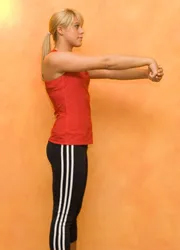Orthopedics
Tennis elbow – epicondylitis
Tennis elbow (epicondylitis humeri radialis)
Pain on the outside of the elbow is common. The cause of this discomfort is often tennis elbow. However, playing tennis is rarely the trigger for this common condition. Non-athletes are more affected than athletes. People who work a lot on computers, cleaning women, and musicians are particularly likely to suffer from severe elbow pain.

Causes of Tennis Elbow The muscles responsible for moving the fingers and wrist are primarily located in the forearm. The muscles responsible for extension almost all originate from a small bony point on the outside of the elbow, the epicondyle of the humeri radialis. This bony point is usually easy to locate, as it is particularly painful in tennis elbow.
High-impact or monotonous activities often lead to an unnatural tension in the muscles at this bone point, which then reacts with inflammation. Often, the forearm muscles are also chronically tense, so that an unnatural tension is constantly present at this bone point.
Pain and weakness in the arm and hand are the result.
Tennis elbow can usually be treated conservatively. Fortunately, surgery is rarely necessary.
To achieve long-term success in treating tennis elbow, attempts should be made to treat the underlying causes of the symptoms.
Avoid the triggering activities or modify movement patterns to protect the elbow and forearm muscles.
Cooling the painful area should reduce inflammation and pain.
Since chronic tension in the forearm muscles usually exists, these muscles must be loosened and stretched.
How does the doctor make the diagnosis?
The correct diagnosis can usually be made based on the patient history and a simple physical examination. X-rays are usually not required, but may be necessary to differentiate tennis elbow from other conditions.
As an additional examination, especially in chronic cases, muscle activity measurement using surface EMG can be performed. This examination can determine the state of muscle tension and, if necessary, provide targeted treatment.
Tennis elbow and therapy
Interesting:
A large Australian study compared the results of various treatment methods worldwide. The impressive finding was that the results without extensive medical therapy were better than those with it. Of course, however, the correct diagnosis should first be made by a doctor.
The therapy
Simple stretching exercises can provide a good stretch for the muscles in the forearm. To do this, fully extend the elbow and gently clench the hand of the affected arm into a fist (but not a forceful one). Then, with the other hand, slowly pull the fist downward at the wrist. You will feel a noticeable pull in the forearm. These are the muscles that originate at the epicondyle of the humeri radialis. Hold this position for about 10 seconds. Then relax the hand and forearm muscles and repeat the exercise about 5 times.


Additionally, a transverse friction massage helps to loosen the muscles. To do this, grasp the forearm with the hand of the healthy side, about 4 cm below the painful bone point. Massage the muscles by massaging the muscles that run from the epicondyle toward the hand, working across the forearm.
TENS therapy can also help with chronic tension. Electrodes are applied to the tense muscles. A gentle, subliminal current leads to muscle relaxation and pain relief. It's important that the treatment lasts for at least 45 minutes per day.
Infiltration of the epicondyle is useful in cases of very severe symptoms, but should not be used as long-term therapy. Too frequent injections, especially with cortisone, tend to make the disease more chronic.




